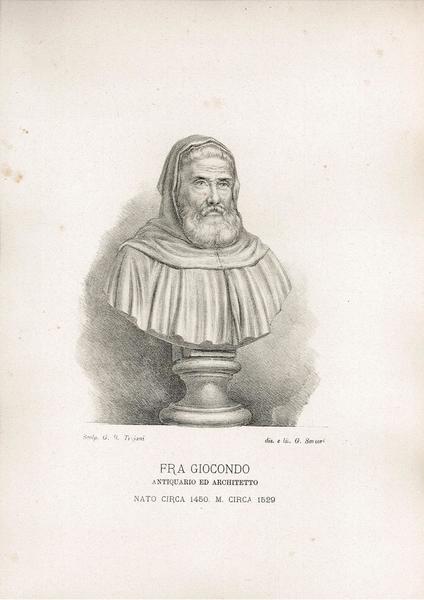30 JUNE 2015
ARTICLES | RELEASES
Giocondo, the friar who defended Venice
Five hundred years ago he died
the Venetian master of fortifications
.
These days are the 500th anniversary of the death of Fra ‘Giocondo, a Veronese religious-architect famous for having revolutionized the system of fortifications, whose most illustrious work is the walls of Treviso, but who was called to Paris, Rome, Padua, in Venice and was also famous for his skills in literature and other sciences. The conclusion of existence is obscure, as fragmentary remains the news about the birth which dates back to around 1434. It is known that he died in Rome before 2 July 1515, the date on which the Venetian Marino Sanuto noted the news of his disappearance in his diary. But not even Vasari found out more.
– Humanist and architect designed the walls of Treviso
He was an architect, archaeologist, scholar of classical antiquity, humanist, one of the greatest geniuses of his time. And it is not risky to compare the image of the Veronese Fra Giocondo with that of the contemporary Leonardo, who can be approached because of his multifaceted talent, which he revealed through the combination of knowledge and genius in various fields.
Yet around Giovanni Monsignori or d’Ognibono there is only the scant information received from Vasari’s Lives and documents, such as a letter from Raphael, who in July 1514 attributed him more than 80 years. We know, moreover, that he wore the religious habit. Also according to Vasari he belonged to the rule of the Dominican Order, although there are other references that would give him as a Franciscan. The peculiarity that made him great lies in the ability he had to range as a man of science between engineering and architecture, and as a man of letters in epigraphic and antiquarian studies. Moving to Rome at a young age, he devoted himself to classical antiquity studies which led him to research, collect and transcribe a large number of inscriptions published by himself and offered to Lorenzo the Magnificent. Praised by Poliziano, who defined him as a “most expert and diligent author”, he earned the esteem of figures of the depth of the Sienese bishop Francesco Patrizi, like him a scholar and expert on Vitruvius. Precisely the juxtaposition between the figures of “antiquarius” and “architectus”, which the prelate grasped in the Dominican of Verona, opens up to the understanding of the great insights he had in the study of fortifications. He designed them in the service of the Duke of Naples and Aragon, then passing to the court of the sovereigns of France. The project for the stone bridge over the Seine near Notre Dame, completed after his departure, and the interventions on the plumbing systems at the Château de Blois that brought to light his engineering knowledge belong to the French period. These are the qualities for which the Venetian government called him to prepare the defensive systems which in 1509 it was urgent to provide in view of the war against the League of Cambrai. Fra Giocondo’s intuitions proved effective. Both in Treviso and in Padua where the defensive works consisted in the demolition of the old and ineffective medieval walls, with the excavation of ditches and the raising of embankments. Here the Veronese monk earned the fame of father of the first modern fortification, revealing knowledge of hydraulic mechanics. In Treviso, in particular, he devised the hydraulic system which, by raising the waters of the Sile, upstream of the city, and those of the Botteniga, flowing from the external pits, managed to cause the flooding of the countryside by isolating the city. In this way Treviso would have been able to effectively oppose the siege of the enemy troops, destined to get bogged down. Skilled designer of the fortification, Fra Giocondo was also versatile in civil architecture. The construction of the Fondaco dei Tedeschi remains testimony to this in Venice, while in 1513 his project for the reconstruction of the Rialto bridge did not pass. This disappointment was certainly compensated by the Pope’s decision who called him to Rome to work alongside Raphael in the continuation of the works for the construction of St. Peter’s. Among the irrefutable testimonies of the knowledge and competence on the philological and literary level of fra Giocondo, protagonist with Pietro Bembo, Aldo Manuzio and Ermolao Barbaro of Venetian humanism, remains the first illustrated edition of the “De architectura” by the Latin writer Vitruvius, published in Venice in 1511. The reprints are very precious, including the Florentine one from 1513.
Article by Bruno De Dona ‘taken from www.gazzettino.it of 29 June 2015

